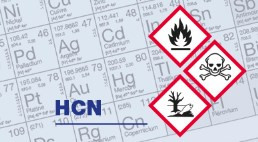Hydrogen Cyanide (HCN)- CAS Number: 74-90-8
Descriptions: Colourless gas, flammable, highly poisonous, transparent or pale blue liquid. It is a very weak acid that is soluble in water and alcohol and unstable with water, heat or alkaline materials.
AKA: Prussic acid; Formic anammonide; Hydrocyanic acid; Methanenitrile
Boiling point: 25.6°C (78.1°F)
Melting point: -13°C (7°F)
Faint bitter almond-like odour. Only certain people, with a genetic trait (about 60 - 70% of the population), can detect the scent at between 1 - 5 ppm in air.
Uses: Rodenticide or pesticide, human poison, chemical warfare; killing whales; used in the manufacturing of paper, plastics and textiles; fumigation; electroplating, removal of gold from ore, mining; organic chemicals production, photography development.
Exposure: inhalation, ingestion, skin or eye contact
Risks: Large volumes of HCN prevent the body from utilizing oxygen by interfering with iron-containing respiratory enzymes. Long term exposure at low concentrations can have an impact on the central nervous system.
Natural sources of cyanide can be obtained from over 2000 plant species including the pits of fruits (bitter almonds, apples, apricots, cassava root); thought to have been part of the origin of life; anthropogenic sources include from vehicle exhaust; from burning of nitrogen containing plastics; passing ammonia over hot coals; cigarette smoke.
Cyanide can be released into the atmosphere through the chemical manufacturing and processing industries. Cyanide can enter the environment via waste and emissions such as from vehicles, burning of fossil fuels, or coal production.
Inhalation of cyanide initially causes rapid breathing, headache, heart palpitations and general restlessness. Vomiting and convulsion symptoms will advance to full respiratory failure and unconsciousness. Immediate death can occur if initial exposure is at an extremely high concentration.
| Concentration (mg/m3) | Effect |
| 300 | Immediately Fatal |
| 200 | Fatal after 10 minutes |
| 150 | Fatal after 30 minutes |
| 120-150 | Highly dangerous (fatal) after 30-60 min |
| 50-60 | Endurable for 20 min. - 1 h without effect |
| 20-40 | Light symptoms after several hours |
”It has been reported that 45 to 54 ppm can be tolerated for 0.5 to 1 hour without immediate or delayed effects while 110 to 135 ppm may be fatal after 0.5 to 1 hour or later, or dangerous to life [Flury and Zernik 1931].”
NIOSH REL: 4.7 ppm (5 mg/m3) STEL [skin]
Current OSHA PEL: 10 ppm (11 mg/m3) TWA [skin]
1989 OSHA PEL: 4.7 ppm (5 mg/m3) STEL [skin]
1993-1994 ACGIH TLV: 10 ppm (11 mg/m3) CEILING [skin]
LEL:. . 5.6% (10% LEL, 5,600 ppm)
Other Hazards:
Extremely Flammable, toxic fumes emitted.
Explosive.
Exposure: avoid all contact. Inhalation is greatest risk. Can be absorbed via skin and eyes.

